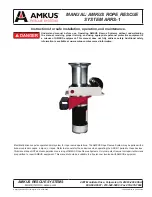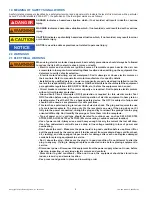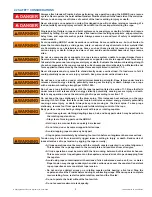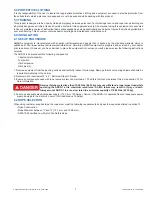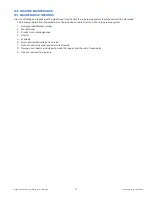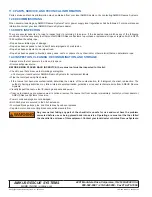
©Copyright Amkus Rescue Systems, Inc. 2018-2020
LAA-002 March 10, 2020 Rev02
9
8.0 OPERATING INSTRUCTIONS
8.1 CONTROLLING A LOAD
In order to control a load, it is necessary to have a feel for the rope. Each rope has a di
ff
erent coe
ffi
cient of friction and generates
a di
ff
erent pulling force. Test the amount of pulling force per two wraps. After estimating the force exerted and before performing a
rescue have a quali
fi
ed technician estimate the number of wraps necessary for the speci
fi
c rescue load.
WARNING
Test the number of wraps to determine their ability to develop tension under capstan rotation.
Wraps should not be added or subtracted from a rotating capstan while bearing a live load. If the
tension must be adjusted during an operation;
• Stop the capstan and lock the Prusiks before adding or subtracting wraps.
• When wraps are complete resume tailing force, restart capstan rotation, and tend the Prusiks.
8.2 LOWERING A LOAD
To lower a load, the operator allows the tail of the rope to feed out slowly around the capstan. Another rescuer “tends” the Prusiks.
(see section 8.4) After the load is lowered, the Prusiks are locked o
ff
. Release the foot switch.
8.3 RAISING A LOAD
To raise a load,
fi
rst step on the foot switch. Once the capstan is rotating, apply pulling force to the tail or fall line of the rope. Continue
to pull the tail line until the load is raised to the desired position. Release the foot switch.
8.4 TENDING PRUSIKS
Tending the Prusiks is an important part of operating the ARRS-1. Depending on how well the Prusiks are tended free fall distances
can be between a fraction of an inch up to 12 inches. Keep all body parts away from pulleys and moving parts on ARRS1. Keep
Prusik locking knots close to end stops. In the event that the user is operating the tailing side without assistance, do not tend the
Prusiks close to the pulleys on the ARRS-1. Instead, prior to the rescue, tie the locking knots on the Prusiks 12” away from the
pulleys.
8.5 ROPE WRAPS AND PREVENTING OVERLAP
As stated in section 7.1, the number of wraps is proportional to the tailing and pulling force of the ARRS-1. However, it is important to
keep the wraps between two and
fi
ve. Less than two wraps can lead to too little friction. A loop slipping without having another left on
the drum can cause a loss of control over the load. Too many wraps can cause excessive heat from friction and rope overlap. Rope
overlap occurs when the tailing rope crosses over the previous layer preventing the rope from slipping on the drum, preventing both
lowering and raising operations. If an overlap begins to develop, relax the rope so that the load will lower past the previous layer.

